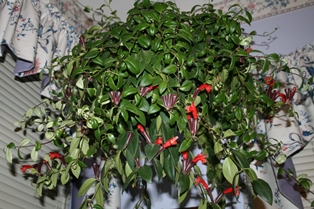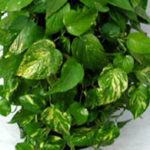Add a Dab of Color with Lipstick Plant
Few indoor plants are as aptly named as the lipstick plant (Aeschynanthus radicans). Right before blooming, this plant has flower buds in dark purple calyxes that actually resemble a tube of lipstick emerging from its case. Flowers are a bright red with a yellow throat and appear off and on throughout the year.
A member of the gesneriad family, the lipstick plant is closely related to African violets and gloxinia. It is native to the damp forests of the West Indies and the tropicalregions of South America. An epiphyte in its natural habitat, the lipstick vine grows on other plants, like orchids. It is usually found growing in the angles of branches in the rainforest, getting its nourishment from fallen leaves and twigs.

In the indoor environment it often looks best as a hanging plant–especially when mature. To successfully grow this eye-catching indoor bloomer, keep the following tips in mind.
Watch Lipstick Plant Lighting. Lipstick plants need a lot of bright light to flower. Avoid direct sunlight, though, especially when the plants are young, as the foliage may burn.
Water Lipstick Plant Wisely. Water lipstick plants when they are approaching dryness. Avoid letting them dry out, but don’t keep excessively moist, especially in the winter months. Always water with warm/tepid water.


Provide lipstick plant humidity. Because they come from the jungle, lipstick vines require high humidity. Leaves may brown and dry if the humidity falls too low. You can mist them, but even more effective is to place them over a humidity tray. Fill a saucer or pot without holes with marbles or pebbles and add some water. The pot’s bottom should sit on the marbles just above water, but not in it. This will provide a constant source of humidity to the plant, as long as you keep the tray supplied with water.
Watch winter temperatures. Avoid exposing the lipstick vine to temperatures below 55 degrees, as this can cause leaf drop. They prefer 70 to 80 degrees.
Feed lipstick plant regularly. To grow well and flower, lipstick plant requires fertilizing every 4 weeks during the spring and summer and once every 6 weeks in the fall and winter. Use a liquid organic food at 1/2-strength.
When to repot. Lipstick vine prefers to be a little pot-bound. If it is put in too large of a pot, it will put its energy into rooting, rather than flowering. When they are young and actively growing, they will probably need repotting once a year in spring or summer. Go up just one pot size. More mature plants can be kept in the same pot for three to four years at a time.
When you do repot, look for a soil that drains well, yet provides moisture retention. A high quality organic potting soil will contain pumice or perlite for drainage. Also look for soil with organic nutrients such as worm castings and bat and bird guano.
Inspect lipstick plant for pests. Lipstick vine is usually not bothered by pests. If the leaves look unhealthy, however, examine the foliage with a 10x hand lens or magnifying glass. Look for spider mites, mealybugs or thrips. Treat with insecticidal soap, neem oil or pyrethrins, according to package directions. In the case of spider mites, which thrive in dry conditions, raise the humidity level.
Wait patiently for lipstick plant blooms. Young lipstick plants don’t flower that often. Blooms appear more regularly once the plant matures.





